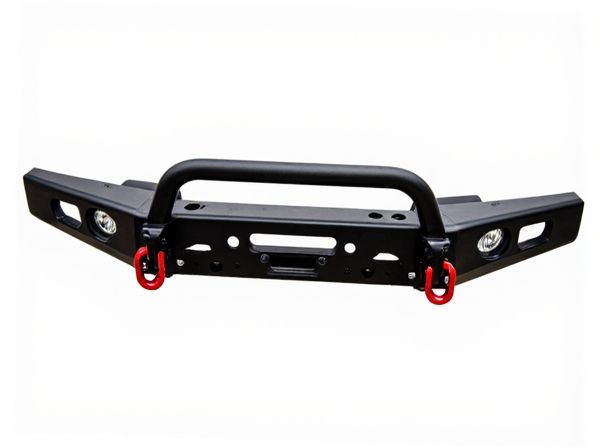
Photo illustration: Winch bumper vs Bull bar
A winch bumper offers robust protection and integrates a winch for vehicle recovery, making it ideal for off-road enthusiasts who need practical functionality. Bull bars focus primarily on safeguarding the front of your vehicle from wildlife impacts and minor collisions, often enhancing the vehicle's aesthetics. Choosing between the two depends on whether your priority is recovery capability or enhanced front-end defense.
Table of Comparison
| Feature | Winch Bumper | Bull Bar |
|---|---|---|
| Primary Function | Winch mount and recovery support | Front-end protection against impacts |
| Material | Heavy-duty steel or aluminum | Steel, aluminum, or stainless steel |
| Weight | Heavier due to winch and structure | Lighter, more streamlined design |
| Protection Level | High impact and recovery protection | Moderate impact protection |
| Installation | Complex, requires mounting points and wiring | Relatively simple bolt-on installation |
| Cost | Higher due to integrated winch feature | Lower, focused on protection only |
| Ideal Use | Off-road recovery and heavy-duty tasks | Urban driving and moderate off-road protection |
Introduction to Winch Bumper and Bull Bar
Winch bumpers are heavy-duty front-end accessories designed to house a winch, offering robust protection and enhanced recovery capabilities for off-road vehicles. Bull bars provide a lighter protective framework primarily aimed at shielding the front grille and headlights from animal strikes and minor impacts. Both accessories improve vehicle durability, but winch bumpers focus on recovery functionality, while bull bars emphasize lightweight protection and aesthetics.
Purpose and Functionality Comparison
Winch bumpers are specifically designed to house a winch securely, providing a robust mounting point and protection during recovery operations, while bull bars primarily shield the front of the vehicle from animal strikes and minor collisions. Winch bumpers offer enhanced structural integrity and attachment options for off-road accessories, supporting heavy-duty towing and pulling tasks, whereas bull bars mainly focus on preventing damage by absorbing impact. The winch bumper integrates recovery functionality, making it essential for off-road and utility vehicles, whereas bull bars prioritize front-end defense and aesthetic enhancement.
Material and Build Quality Differences
Winch bumpers are typically constructed from heavy-duty steel or aluminum alloys designed to support the weight and mechanical stress of a winch system, ensuring durability and strength during recovery operations. Bull bars, on the other hand, often utilize lighter materials such as aluminum or tubular steel, prioritizing front-end protection against animal impacts and minor collisions rather than heavy load-bearing capacity. The build quality of winch bumpers emphasizes reinforced mounting points and robust welds to withstand winching forces, while bull bars focus on corrosion resistance and aerodynamic design for vehicle compatibility.
Installation Process and Compatibility
Winch bumpers require precise mounting points and often need additional reinforcement for secure winch integration, making their installation more complex compared to bull bars. Bull bars typically have a simpler bolt-on installation process compatible with most vehicle front ends but may lack provisions for heavy-duty winch mounting. Compatibility varies as winch bumpers are custom-designed to fit specific winch models and vehicle chassis, while bull bars offer broader fitment options but limited winch accommodation.
Winch Integration Capabilities
Winch bumpers offer superior winch integration capabilities compared to bull bars, featuring reinforced mounting points specifically designed to securely house heavy-duty winches. This integration allows for seamless recovery operations, providing enhanced durability and safety during off-road winching tasks. Bull bars generally lack dedicated winch mounting structures, making winch installation more complex and less stable.
Protection Level for Vehicle Front End
Winch bumpers offer moderate protection to the vehicle front end, primarily designed to support winch mounting and prevent minor impacts from debris or small obstacles. Bull bars provide a higher level of protection by shielding the grille, headlights, and front bumper from collisions with larger objects, such as animals or off-road hazards. When prioritizing front-end safety, bull bars are typically more robust and effective in preventing damage compared to winch bumpers.
Off-Road Performance and Utility
Winch bumpers provide superior off-road utility by integrating a winch mount, enabling vehicle recovery in challenging terrains and enhancing self-reliance during obstacles like mud or steep inclines. Bull bars offer robust front-end protection against animal strikes and brush but typically lack the specialized winch attachment, limiting their recovery functionality. Off-road enthusiasts prioritize winch bumpers for their dual function of defense and recovery, while bull bars are favored for simpler impact protection and improved approach angles.
Aesthetic Impact on Vehicle Appearance
Winch bumpers typically provide a rugged, functional look that emphasizes utility without overwhelming the vehicle's original design, often integrating seamlessly with modern SUV and truck aesthetics. Bull bars offer a more aggressive, bold appearance, prominently enhancing the front end's visual impact by adding a robust frame that can dominate the vehicle's facade. Choosing between the two depends on the desired balance between maintaining sleek vehicle lines and projecting a tough, off-road-ready image.
Legal and Safety Considerations
Winch bumpers and bull bars differ significantly in legal and safety considerations, with many regions imposing strict regulations on bull bars due to their potential to cause harm to pedestrians and wildlife during collisions. Winch bumpers often comply more readily with road safety standards because they are designed to house recovery gear without extending excessively beyond the vehicle's profile, reducing the risk of injury. Understanding local vehicle modification laws and adhering to safety standards for impact absorption and pedestrian protection is crucial when choosing between a winch bumper and a bull bar.
Cost and Value for Money
Winch bumpers typically cost more upfront due to the integrated winch mechanism, offering significant value for off-road recovery and heavy-duty utility. Bull bars are generally less expensive, providing essential front-end protection but lacking winching capabilities, making them more suitable for budget-conscious buyers prioritizing basic impact defense. Evaluating cost against functionality, winch bumpers deliver greater long-term value for serious off-road enthusiasts, while bull bars offer a cost-effective solution for everyday roadside protection.
 caratoz.com
caratoz.com